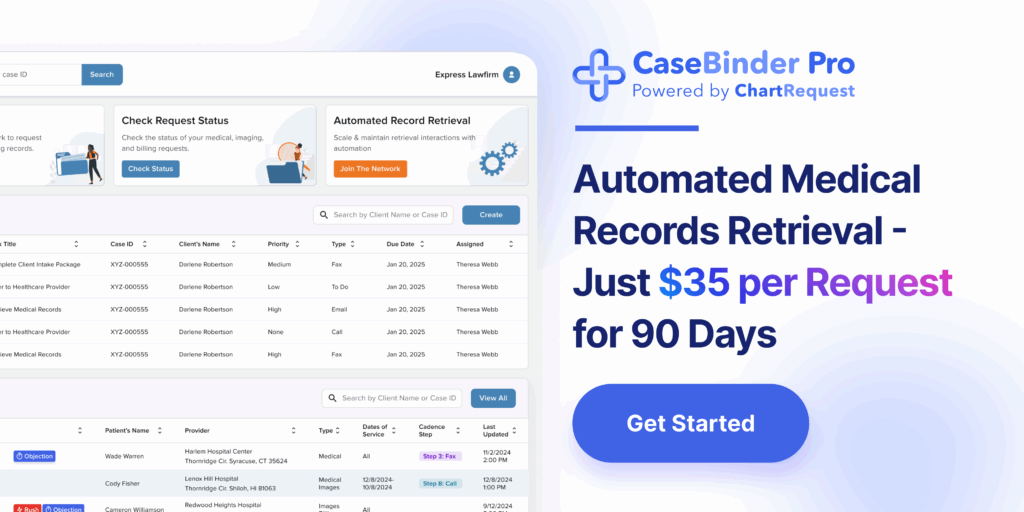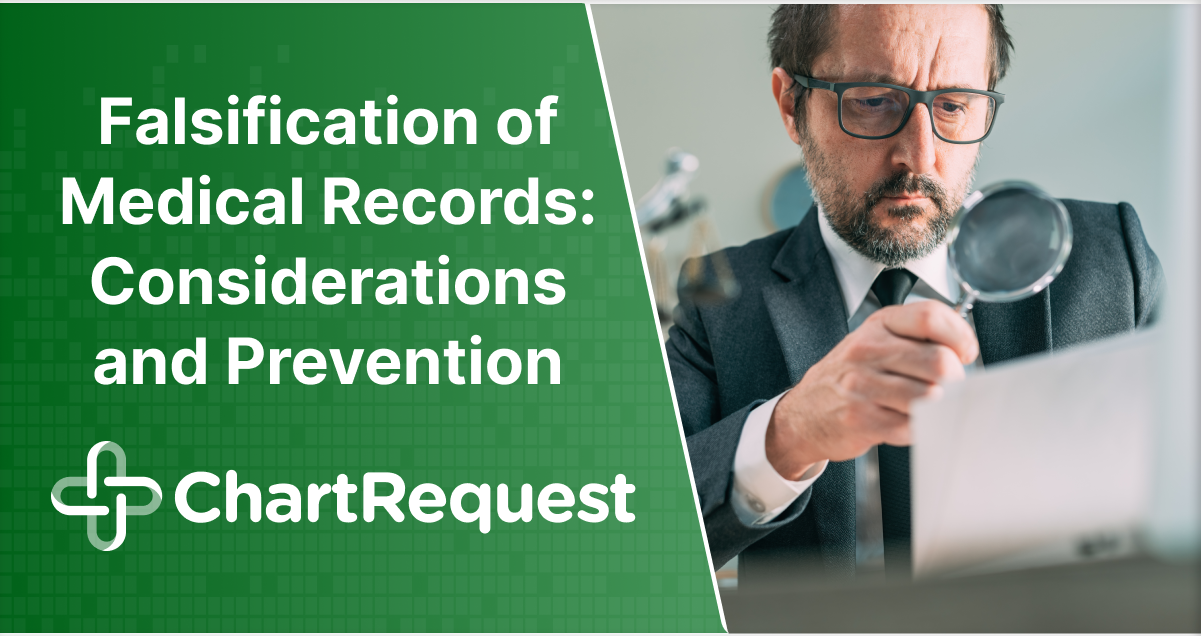Every attorney knows that the falsification of medical records can land their practice in hot water. Making or accepting deliberate changes and omissions can damage your law firm’s reputation and potentially result in malpractice lawsuits or convictions for responsible parties.

However, you may not know that you can significantly reduce the risk of obtaining falsified medical records through services like ChartRequest. Continue reading to better understand accidental and intentional record falsification and how to prevent invalid records from reaching your desk.
Want answers fast? Book a demo to see how we can automate the retrieval of certified medical records.
What Constitutes Falsification of Medical Records?
Both physical and electronic health records (EHRs) are prone to falsification. Some common examples of falsification include:
- Altering dates to cover up mistakes in treatment timelines.
- Adding false information to suggest treatments or procedures that never occurred.
- Omitting critical details about a patient’s condition or medical history.
- Modifying test results to manipulate patient outcomes or avoid liability.
Intentional vs. Unintentional Falsification
An intentional falsification of medical records happens when a doctor, attorney, or patient purposely changes information to deceive courts or insurance companies.
Unintentional falsification occurs from accidental errors, miscommunication, or flaws in the record-keeping procedure. It’s important to understand that attorneys can make this mistake while collecting and organizing sensitive health information for a case.
Regardless of intent, both types of falsification carry significant legal implications. Deliberately falsifying information can result in criminal charges, civil lawsuits, or fines. Healthcare fraud — which includes falsification of medical records — costs the U.S. approximately $68 billion annually.
Legal Implications of Falsifying Medical Records
Foundational laws that address falsification of medical records include:
Health Insurance Portability and Accountability Act (HIPAA)
HIPAA safeguards your clients’ protected health information (PHI). Altering medical records violates HIPAA’s Privacy Rule, which mandates accurate and complete documentation.
18 U.S. Code § 1035
The 18 U.S. Code § 1035 federal statute makes healthcare fraud a felony. Penalties include up to five years in prison and/or fines of up to $250,000 for falsifying healthcare information.
False Claims Act (FCA)
The FCA prohibits submitting falsified medical records to secure improper payments from government programs like Medicare or Medicaid.
The U.S. government loses an estimated $105 billion annually due to false healthcare claims.
State Penalties
Specific states impose additional penalties in their laws. For example, Maryland statutes dictate that any healthcare provider who knowingly alters or obscures medical records to hide evidence may be guilty of a misdemeanor.
Penalties include fines of up to $5,000, imprisonment for up to one year, and losing one’s medical license.
Operation Backlash: Cracking Down on California Workers’ Compensation System (CWCS)
In recent years, healthcare fraud investigations have surged. These legal initiatives emphasize the need for a more robust anti-fraud enforcement framework.
Operation Backlash was one such response.
This multi-agency effort targeted corruption within the California Workers’ Compensation System (CWCS) for nearly four years. It uncovered widespread falsification of medical records within CWCS involving legal and medical professionals.
The fraudulent scheme led to losses exceeding half a billion dollars to the CWCS. After a thorough investigation, more than 30 conspirators received severe punishment. Along with a prison sentence, the court also ordered them to pay large financial penalties.
The success of Operation Backlash demonstrates that even legal professionals must practice extreme caution when scrutinizing and using patient health information.
How To Identify Falsified Medical Records
Detecting falsified medical records can be challenging if the fraudster is subtle. If you suspect fraud, these details may uncover your smoking gun:
- Inconsistent Treatment Dates: Gaps or mismatched treatment dates can indicate an attempt to hide errors or cover up negligence.
- Incorrect Patient History: Sudden or unexplained changes in a patient’s medical history, such as missing diagnoses or treatments, may signal intentional omissions.
- Altered or Missing Signatures: If signatures from healthcare providers seem forged or missing entirely, it could point to tampered documentation.
- Unusual Modifications: Sections of the records that appear edited after the date of filing, overwritten, or suspiciously corrected may indicate tampering.
- Inconsistent Information Between Records: Compare records from different healthcare providers or departments. Unexplained differences in treatment details can indicate falsification of medical records.
Cross-Referencing Documents
Compare suspicious medical records with other available evidence, such as billing statements, lab reports, or pharmacy records. Discrepancies between these sources may reveal falsified information.
Reviewing Metadata in EHRs
EHR metadata provides detailed information about when and how modifications in records occurred. Checking the metadata allows you to track any unauthorized changes to patient data.
These tasks may require court-issued subpoenas depending on the source of the metadata and individual state laws.
How Does Certification Prevent the Falsification of Medical Records?
Notarization certifies the authenticity of medical documents.
Types of Notarization for Healthcare Documents
Certified medical records carry legal weight, making them admissible in court without the risk of discrepancies or forgery. These types of notarizations help reduce the chances of falsified medical records.
- Acknowledgments: These notarizations confirm that the signer is who they claim to be and consent to signing. Acknowledgments are useful for documents such as powers of attorney (PoA) and healthcare directives.
- Jurats: Jurats verify that the signer swears or affirms that the contents of the document are true.
- Oaths/Affirmations: Administering a verbal oath or affirmation compels all parties to be truthful.
- Copy Certifications: These elements confirm that a copy of an original healthcare document is a full, true, and accurate transcription.
- Advanced Directives or Healthcare Directives: These documents legally recognize a patient’s wishes regarding their medical treatment. They include living wills and durable healthcare PoA.
- Witness Ombudsman: States like California and Texas require one or two special witnesses when notarizing advanced directives in nursing homes.
Retrieve and Certify Medical Records With ChartRequest
The widespread use of EHR systems and the new laws on notary services have made digital healthcare certification essential. CaseBinder by ChartRequest provides a fast and reliable way to retrieve certified medical records.
Don’t let falsification of medical records slow your legal team down. Our digital notary feature adds a layer of authenticity, making it harder for falsified records to slip through the cracks.
Book a call with one of our ChartRequest experts today and take the first step towards accurate and complete medical record retrieval.


